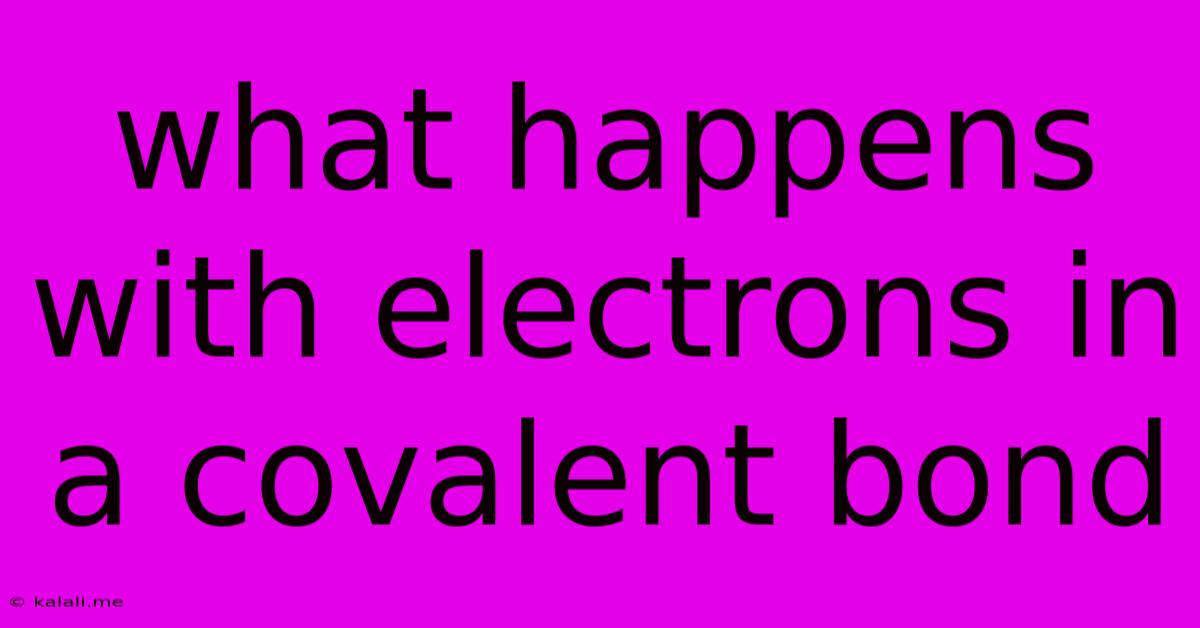What Happens With Electrons In A Covalent Bond
Kalali
Jun 02, 2025 · 3 min read

Table of Contents
What Happens to Electrons in a Covalent Bond? A Deep Dive into Shared Electron Pairs
Covalent bonds are the fundamental building blocks of many molecules, from the simple water molecule to complex biological macromolecules like DNA. Understanding what happens to electrons in a covalent bond is crucial to grasping the behavior and properties of these molecules. This article explores the intricacies of electron sharing in covalent bonds, explaining the process, its implications, and related concepts.
What is a Covalent Bond?
A covalent bond forms when two atoms share one or more pairs of electrons. This sharing allows each atom to achieve a stable electron configuration, usually a full outer electron shell, similar to the stable electron configuration of noble gases. Unlike ionic bonds, where electrons are transferred from one atom to another, covalent bonds involve a more collaborative arrangement where electrons are mutually "owned".
The Mechanics of Electron Sharing:
The shared electrons are attracted to the positively charged nuclei of both atoms involved in the bond. This mutual attraction holds the atoms together, forming the bond. The strength of the bond depends on the extent of electron sharing and the electronegativity difference between the atoms.
-
Electronegativity: This property describes an atom's ability to attract electrons in a chemical bond. Atoms with similar electronegativities form nonpolar covalent bonds, where the electrons are shared equally. Atoms with significantly different electronegativities form polar covalent bonds, where the electrons are shared unequally, resulting in a slightly positive (δ+) end and a slightly negative (δ-) end of the molecule. Think of water (H₂O) as a prime example of a molecule with polar covalent bonds.
-
Orbitals and Overlap: Covalent bonds are formed by the overlap of atomic orbitals. This overlap allows the electrons to be shared between the two atoms. The greater the overlap, the stronger the bond. The specific type of orbital overlap (e.g., s-s, s-p, p-p) influences the geometry of the molecule.
-
Sigma (σ) and Pi (π) Bonds: A single covalent bond is typically a sigma bond, formed by the direct head-on overlap of atomic orbitals. Double and triple bonds involve sigma bonds plus one or two pi (π) bonds, respectively. Pi bonds are formed by the sideways overlap of p orbitals, resulting in a weaker bond compared to sigma bonds.
Consequences of Electron Sharing:
The sharing of electrons in a covalent bond has several important consequences:
-
Stable Molecule Formation: The primary outcome is the formation of a stable molecule with lower overall energy than the individual atoms. This stability arises from the fulfillment of the octet rule (or duet rule for hydrogen) for each atom.
-
Molecular Properties: The type of covalent bond (polar or nonpolar) significantly influences the properties of the molecule. Polar molecules tend to have higher boiling points and melting points due to stronger intermolecular forces (dipole-dipole interactions and hydrogen bonding).
-
Reactivity: The electron distribution within a molecule, determined by the covalent bonds, dictates its reactivity. Molecules with unshared electron pairs or regions of high electron density are often more reactive.
-
Bond Length and Bond Energy: The distance between the nuclei of the bonded atoms is called the bond length. The energy required to break the bond is called the bond energy. Both are related to the strength of the covalent bond. Shorter bond lengths typically correspond to stronger bonds and higher bond energies.
Beyond the Basics:
The picture of electron sharing presented above is a simplified model. In reality, the electron distribution in a covalent bond is more complex and can be described using advanced concepts like molecular orbital theory. This theory provides a more accurate depiction of bonding in molecules, particularly those with multiple bonds or delocalized electrons.
In conclusion, covalent bonds are formed by the sharing of electrons between atoms, leading to stable molecules with unique properties. Understanding the mechanics of electron sharing, including electronegativity, orbital overlap, and the distinction between sigma and pi bonds, is fundamental to comprehending the behavior of molecules in various chemical and biological systems.
Latest Posts
Latest Posts
-
How To Turn Brownie Mix Into Cake
Jun 03, 2025
-
Self Tapping Mini Valve To Drain Shower Head
Jun 03, 2025
-
What Will Overflow A 4 Bit Program
Jun 03, 2025
-
Did Jonah Die In The Fish
Jun 03, 2025
-
Salesforce List View Custom Action Button Not Showing
Jun 03, 2025
Related Post
Thank you for visiting our website which covers about What Happens With Electrons In A Covalent Bond . We hope the information provided has been useful to you. Feel free to contact us if you have any questions or need further assistance. See you next time and don't miss to bookmark.